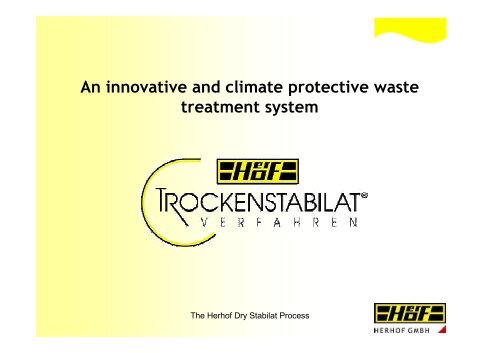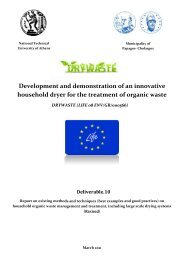Presentation of Herhof Technology
Presentation of Herhof Technology
Presentation of Herhof Technology
Create successful ePaper yourself
Turn your PDF publications into a flip-book with our unique Google optimized e-Paper software.
An innovative and climate protective waste<br />
treatment system<br />
The Herh<strong>of</strong> Dry Stabilat Process
Advantages <strong>of</strong> the Herh<strong>of</strong> technology<br />
• Waste to energy<br />
• No waste material for landfilling<br />
• Biological drying increases calorific value<br />
• Separation <strong>of</strong> waste into material for energy recovery<br />
and material recovery<br />
• 50% <strong>of</strong> input material transferred into secondary fuel<br />
• Secondary fuel has 2/3 <strong>of</strong> organic material<br />
• CO 2 savings for 2/3 <strong>of</strong> the output material (Stabilat)<br />
The Herh<strong>of</strong> Dry Stabilat Process
Herh<strong>of</strong> Stabilat ® plants:<br />
Complete planning<br />
Turnkey construction<br />
Longterm operation<br />
6 plants in operation (Osnabrück, Rennerod, Aßlar,<br />
Dresden, Geel, Venedig)<br />
1 plant under construction (Nuthe-Spree)<br />
The Herh<strong>of</strong> Dry Stabilat Process
Stabilat ® technology – Using MSW as a resource<br />
Material<br />
Recovery<br />
Energy<br />
Recovery<br />
Substitude Fuel Stabilat ®<br />
• homogenous<br />
• high calorific<br />
• low heavy metal content • storable/ transportable<br />
Condensate / Permeate<br />
30%<br />
NF*= Nonferrous<br />
Metals Inerts/ Glass<br />
Fe NF* 12%<br />
4 % 1% Batteries / Electronic scrap<br />
The Herh<strong>of</strong> Dry Stabilat Process<br />
Stabilat ®<br />
53%
Herh<strong>of</strong> Stabilat ® <strong>Technology</strong><br />
- with glass separation -<br />
MSW/ Commercial waste 100 %<br />
Crushing<br />
< 150 mm<br />
Evaporation in<br />
cooling tower<br />
Biological drying<br />
Condensate / Organics approx. 30 %<br />
Exhaust air<br />
Dry waste<br />
Bypass<br />
Dried MSW Approx.<br />
70 %<br />
Densimetric Separation<br />
Light material/<br />
dust<br />
Approx.<br />
50 %<br />
Stabilat ®<br />
Ferrous<br />
Foil separation (option)<br />
Heavy fraction<br />
Approx.<br />
20 %<br />
Nonferrous-<br />
Metals<br />
Energy recovery<br />
Foils<br />
x<br />
The Herh<strong>of</strong> Dry Stabilat Process<br />
Industry<br />
Plastic recycling
Separation <strong>of</strong> the heavy fraction<br />
ca. 20 %<br />
Heavy fraction<br />
Densymetric<br />
separation<br />
ca. 3 %<br />
Light material<br />
dry stabilat ®<br />
Metal separation<br />
Fe-metals ca. 4 %<br />
NE-metals ca. 1 %<br />
batteries<br />
ca. 0,5 kg/Mg<br />
Option:<br />
Glas separation<br />
optical/<br />
mechanical<br />
minerals<br />
White glas ca. 2 %<br />
Green glass<br />
ca. 0,5 %<br />
Brown glass ca. 0,5 %<br />
ca. 9 %<br />
landfill<br />
The Herh<strong>of</strong> Dry Stabilat Process<br />
Street<br />
building
View <strong>of</strong> a plant<br />
(MBS Osnabrück)<br />
The Herh<strong>of</strong> Dry Stabilat Process
Composting boxes<br />
The Herh<strong>of</strong> Dry Stabilat Process
Herh<strong>of</strong> box with process crane<br />
The Herh<strong>of</strong> Dry Stabilat Process
Ventilation corridor<br />
The Herh<strong>of</strong> Dry Stabilat Process
Condensate cleaning<br />
The Herh<strong>of</strong> Dry Stabilat Process
Exhaust air cleaning<br />
The Herh<strong>of</strong> Dry Stabilat Process
LARA air cleaning<br />
The Herh<strong>of</strong> Dry Stabilat Process
Machinery Hall<br />
The Herh<strong>of</strong> Dry Stabilat Process
Wind sighter<br />
Feeding<br />
Perforated floor<br />
Heavy weight fraction<br />
Air<br />
Vibrating engine<br />
Air<br />
Light weight fraction<br />
The Herh<strong>of</strong> Dry Stabilat Process
Wind sighter<br />
Air<br />
Light weight fraction<br />
Heavy weight fraction<br />
The Herh<strong>of</strong> Dry Stabilat Process
Batteries<br />
The Herh<strong>of</strong> Dry Stabilat Process
Stabilat ® – Fluff<br />
Stabilat ® – S<strong>of</strong>tpellet<br />
The Herh<strong>of</strong> Dry Stabilat Process
Stabilat ® – Hardpellet<br />
The Herh<strong>of</strong> Dry Stabilat Process
Composition <strong>of</strong> stabilat ®<br />
Heating value<br />
Water content<br />
Percentage <strong>of</strong> the total<br />
waste throughput<br />
: 15 - 18 MJ/kg<br />
: ca. 15 weight-%<br />
: ca. 53 weight-%<br />
non-combustible<br />
material (stones, glass,<br />
metals)<br />
Increase <strong>of</strong> calorific value<br />
18.000<br />
appr. 17.000<br />
16.000<br />
kJ / kg<br />
14.000<br />
12.000<br />
10.000<br />
8.000<br />
appr. 9.500<br />
appr. 12.000<br />
6.000<br />
4.000<br />
2.000<br />
0<br />
MSW<br />
40% Moisture<br />
After biological drying<br />
Stabilat® after inert separation<br />
The Herh<strong>of</strong> Dry Stabilat Process
Calorific values <strong>of</strong> different fuels in comparison<br />
Fuels Calorific value Calorific value<br />
[kJ/kg] [Btu/lbs]<br />
Lignite 8,000 – 16,000 3,600 – 7,200<br />
Wood 10,500 – 16,500 4,500 – 7,100<br />
Paper 13,500 5,800<br />
Stabilat ® 16,000 – 18,000 6,900 – 7,800<br />
Pulverized<br />
lignite<br />
20,000 8,600<br />
Hard coal 22,000 – 33,000 9,500 – 14,200<br />
Heating oil 42,000 18,100<br />
The Herh<strong>of</strong> Dry Stabilat Process
Energy recovery<br />
1,000 tons Stabilat equal approx.<br />
• 447 MJ (heat recocery) and<br />
• 114 kW (el. Power)<br />
The Herh<strong>of</strong> Dry Stabilat Process
Comparison <strong>of</strong> traditional mass burn and the Herh<strong>of</strong> Stabilat ® process<br />
in terms <strong>of</strong> heavy metal reduction<br />
- Cadmium -<br />
Scenario 1: Combustion in incinerator<br />
1 metric<br />
ton<br />
MSW<br />
8,5 g Cd<br />
Mass Burn<br />
Scenario 2: Recovery by Stabilat ® <strong>Technology</strong><br />
Cd reduction in fuel -94 %<br />
1 metric<br />
ton<br />
MSW<br />
0,55 g Cd<br />
Industrial Use<br />
8,5 g Cd<br />
Export via Stabilat ®<br />
7,95 g Cd<br />
The Herh<strong>of</strong> Dry Stabilat Process<br />
Export via metals, batteries and electronic scrap
Energy Related Heavy Metal Reduction<br />
MSW vs. Stabilat ®<br />
14<br />
50<br />
mg/MJ<br />
12<br />
10<br />
8<br />
40<br />
30<br />
6<br />
20<br />
4<br />
2<br />
- 92,3%<br />
- 87,4%<br />
- 87,9%<br />
10<br />
- 86,6% - 86,0%<br />
- 81,7%<br />
- 70,8%<br />
0<br />
As Cd Hg<br />
0<br />
Sb Zn Cu Pb<br />
Residual Waste (Lahl 2000) Stabilat ® -Analysis 2000/2001<br />
The Herh<strong>of</strong> Dry Stabilat Process
Energy Recovery with Stabilat ®<br />
Industrial energy<br />
recovery:<br />
Co combustion<br />
• Cement kilns<br />
• Power plants<br />
Material utilisation<br />
• Gasification with the IPV process<br />
• Production <strong>of</strong> diesel fuel<br />
• Production <strong>of</strong> methanol<br />
• Energy and heat generation<br />
The Herh<strong>of</strong> Dry Stabilat Process
Bottom Ash from 1 metric ton MSW<br />
350<br />
300<br />
250<br />
200<br />
150<br />
100<br />
50<br />
0<br />
kg<br />
600 lbs<br />
500 lbs<br />
400 lbs<br />
300 lbs<br />
200 lbs<br />
MSW Stabilat ® 100 lbs<br />
MSW<br />
Stabilat ®<br />
The Herh<strong>of</strong> Dry Stabilat Process
Climate effective CO 2 -emissions<br />
- comparison <strong>of</strong> fossil energy sources with stabilate ® -<br />
energy source<br />
Overall CO 2 -<br />
emission<br />
factor<br />
heat value<br />
specific<br />
Overall-CO 2 -<br />
emissions<br />
regenerative<br />
energy<br />
contingent<br />
specific<br />
fossil CO 2 -<br />
emissions<br />
fossil CO 2 -<br />
emission<br />
factor<br />
g CO 2 /MJ MJ/kg g CO 2 /kg<br />
%-energy<br />
contingent g CO 2 / kg g CO 2 /MJ<br />
brown coal 111 8,6 955 0% 955 111<br />
hard coal 93 29,7 2.762 0% 2.762 93<br />
fuel oil 74 35,4 2.620 0% 2.620 74<br />
natural gas 56 31,7 1.775 0% 1.775 56<br />
stabilate 71 15 1.067 66,8% 354 24<br />
The Herh<strong>of</strong> Dry Stabilat Process
Status report for the contribution <strong>of</strong> the waste management<br />
to climate protection and possible potentials<br />
Source: Öko Institut e.V. and ifeu Heidelberg GmbH; August 2005<br />
by order <strong>of</strong> Bundesumweltamt<br />
There are 3 alternative processes for MSW:<br />
1. Conventional MBT with disposal <strong>of</strong> the rotting residuals in a waste<br />
incineration plant<br />
2. MBT with fermentation <strong>of</strong> the „wet fraction“, drying <strong>of</strong> the<br />
frementation residuals in a curing area and disposal in a waste<br />
incineration plant<br />
3. Mechanical-Biological Stabilisation (MBS) with drying <strong>of</strong> the<br />
complete input by means <strong>of</strong> an intense rotting process; mechanical<br />
separation <strong>of</strong> the dry waste in a secondarye fuel fraction, metals<br />
and inerts<br />
The Herh<strong>of</strong> Dry Stabilat Process
Status report for the contribution <strong>of</strong> the waste management<br />
to climate protection and possible potentials<br />
Source: Öko Institut e.V. and ifeu Heidelberg GmbH; August 2005<br />
by order <strong>of</strong> Bundesumweltamt<br />
Concerning the mentioned criterias there is no basic difference between<br />
the three processes.<br />
But it is assumed that the MBS will put the other two processes out <strong>of</strong><br />
business - under the premise that no residuals will be sent to landfill,<br />
because in connection with energy recovery the MBS is the cheapest<br />
process.<br />
The Herh<strong>of</strong> Dry Stabilat Process










